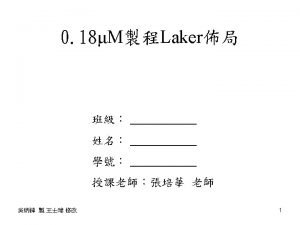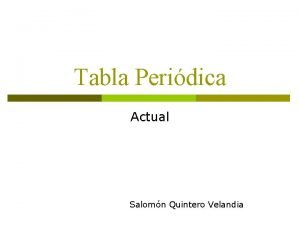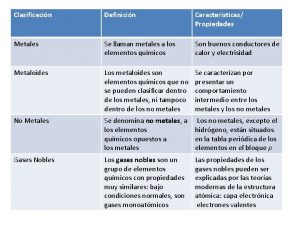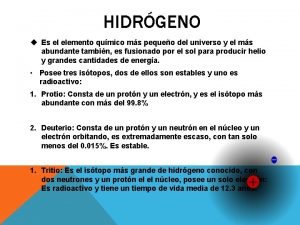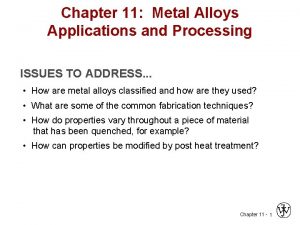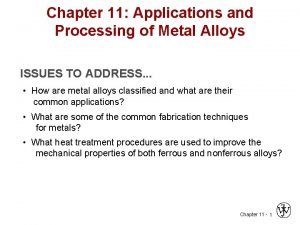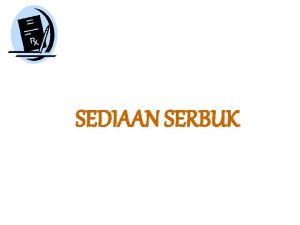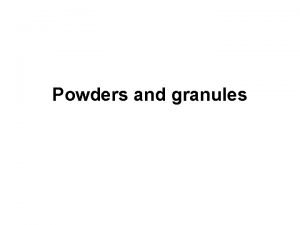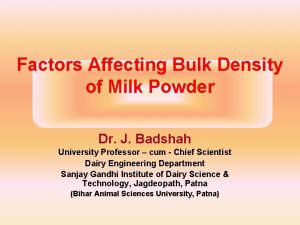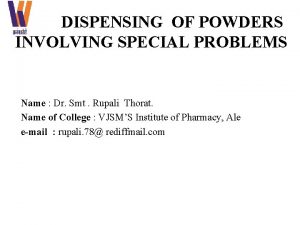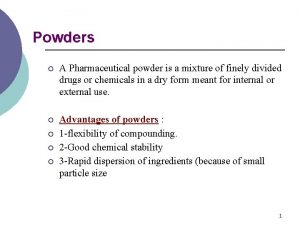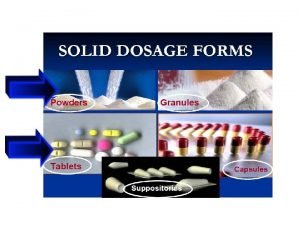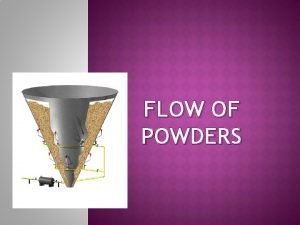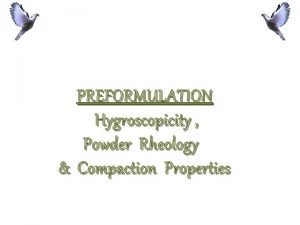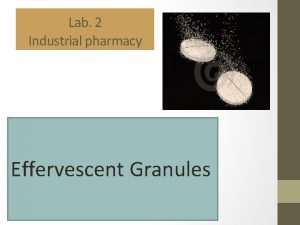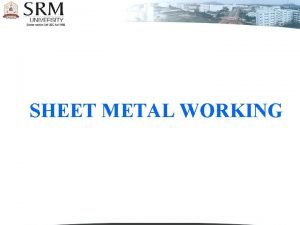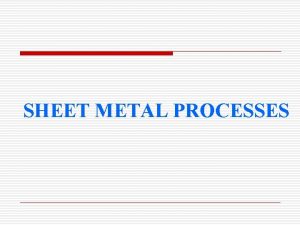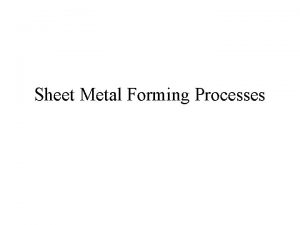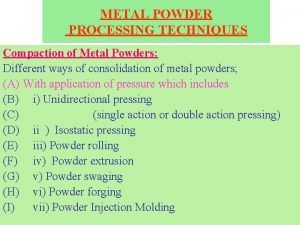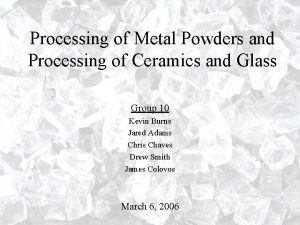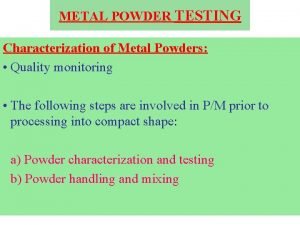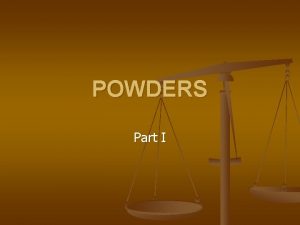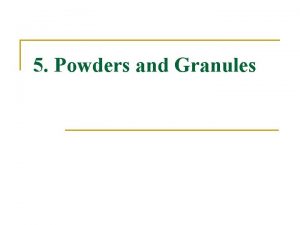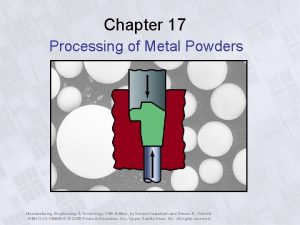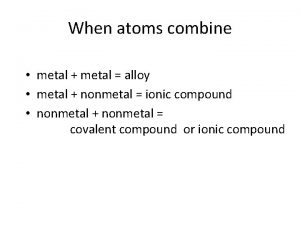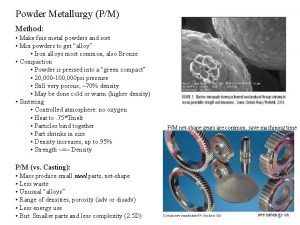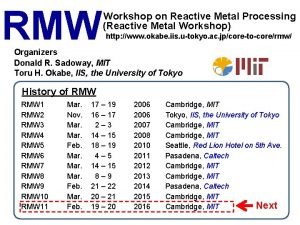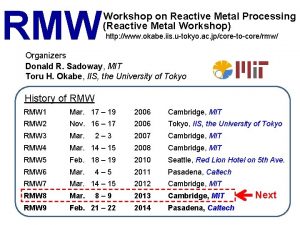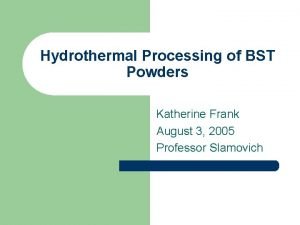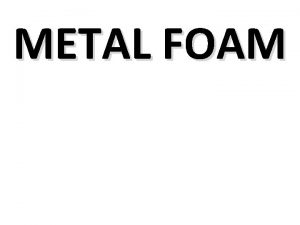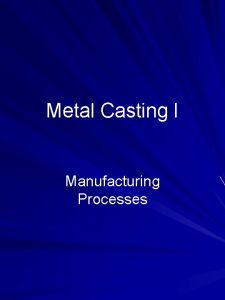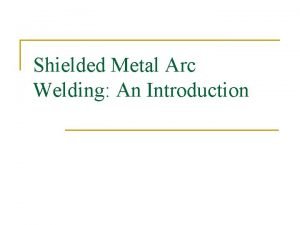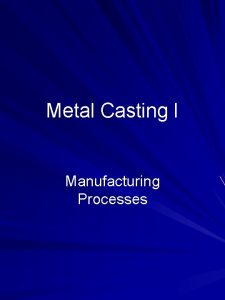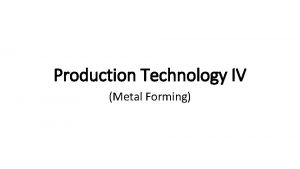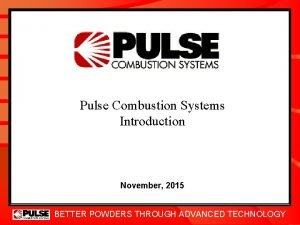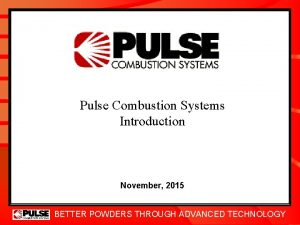Chapter 17 Processing of Metal Powders Introduction The












![Methods of Powder Production-Carbonyls. – Metal carbonyls, such as iron carbonyl [Fe(CO)5] and nickel Methods of Powder Production-Carbonyls. – Metal carbonyls, such as iron carbonyl [Fe(CO)5] and nickel](https://slidetodoc.com/presentation_image_h2/539c982b3b80a3db6d69146c27f71788/image-13.jpg)







































- Slides: 52

Chapter 17 Processing of Metal Powders

Introduction • The powder metallurgy (P/M) process, in which metal powders are compacted into desired and often complex shapes and sintered (heated without melting) to form a solid piece. • Powder metallurgy has become competitive with processes such as casting, forging, and machining, particularly for relatively complex parts made of high strength and hard alloys. • Most parts weigh less than 2. 5 kg, they can weigh as much as 50 kg. • The most commonly used metals in PM are iron, copper, aluminum, tin, nickel, titanium, and the refractory metals

Parts Made by Powder-Metallurgy (b) (c) (a) Figure 17. 1 (a) Examples of typical parts made by powder-metallurgy processes. (b) Upper trip lever for a commercial sprinkler made by P/M. This part is made of an unleaded brass alloy; it replaces a die-cast part with a 60% savings. (c) Main-bearing metal-powder caps for 3. 8 and 3. 1 liter General Motors automotive engines. Source: (a) and (b) Reproduced with permission from Success Stories on P/M Parts, 1998. Metal Powder Industries Federation, Princeton, New Jersey, 1998. (c) Courtesy of Zenith Sintered Products, Inc. , Milwaukee, Wisconsin.

Production of Metal Powders • The powder-metallurgy process consists of the following operations, in sequence (see Fig. 17. 2): • Powder production • Blending • Compaction • Sintering • Finishing operation

Steps in Making Powder-Metallurgy Parts Figure 17. 2 Outline of processes and operations involved in making powder-metallurgy parts.

Methods of Powder Production The microstructure, bulk and surface properties, chemical purity, porosity, shape, and size distribution of the particles depend on the method used (see Figs. 17. 3 & 17. 4). Such characteristics significantly affect the flow and permeability during compaction and in subsequent sintering operations. Particle sizes produced range from 0. 1 to 1000 μm. Figure 17. 3 Particle shapes in metal powders, and the processes by which they are produced. Iron powders are produced by many of these processes.

Methods of Powder Production-Atomization – Atomization produces a liquid-metal stream by injection molten metal through a small orifice. – The stream is broken by jets of inert gas or air gas atomization (Fig. 17. 5 a), or water atomization (Fig. 17. 5 b). – The size and shape of the particles formed depends on the temperature of the molten metal, rate of flow, nozzle size, and jet characteristics. – Use of water results in slurry of metal powder and liquid at the bottom of the atomization chamber. Although the powders must be dried before they can be used, the water allows for rapid cooling of the particles and higher production rates. – Gas atomization usually results in more spherical particles (See Fig. 17. 3 c).

Methods of Powder Production-Atomization • In centrifugal atomization, the molten-metal stream drops onto a rapid rotating disk or cup, so that centrifugal forces break up the molten-metal stream and generate particles (Fig. 17. 5 c). • In another centrifugal atomization, a consumable electrode is rotated rapidly (about 15, 000 rev/min) in a helium-filled chamber (Fig. 17. 5 d). The centrifugal force breaks up the molten tip of the electrode into metal particles.

Powder Particles (a) (b) Figure 17. 4 (a) Scanning-electron-microscopy photograph of iron-powder particles made by atomization. (b) Nickel-based superalloy (Udimet 700) powder particles made by the rotating electrode process; see Fig 17. 5 c. Source: Courtesy of P. G. Nash, Illinois Institute of Technology, Chicago.

Methods of Metal-Powder Production by Atomization Figure 17. 5 Methods of metal-powder production by atomization: (a) gas atomization; (b) water atomization; (c) atomization with a rotating consumable electrode; and (d) centrifugal atomization with a spinning disk or cup.

Methods of Powder Production-Reduction – The reduction of metal oxides (i. e. , removal of oxygen) uses gases, such as hydrogen and carbon monoxide, as reducing agents. – Very fine metallic oxides are reduced to the metallic state. – Powders produced are spongy and porous and have uniformly sized spherical or angular shapes.

Methods of Powder Production-Electrolytic deposition – Utilizes either aqueous solution or fused salts. – The powders produced are among the purest available.
![Methods of Powder ProductionCarbonyls Metal carbonyls such as iron carbonyl FeCO5 and nickel Methods of Powder Production-Carbonyls. – Metal carbonyls, such as iron carbonyl [Fe(CO)5] and nickel](https://slidetodoc.com/presentation_image_h2/539c982b3b80a3db6d69146c27f71788/image-13.jpg)
Methods of Powder Production-Carbonyls. – Metal carbonyls, such as iron carbonyl [Fe(CO)5] and nickel carbonyl [Ni(CO)4], are formed by letting iron or nickel react with carbon monoxide. – The reaction products are then decomposed to iron and nickel, and they turn into small, dense, uniformly spherical particles of high purity.

Methods of Powder Production-Comminution. – Mechanical comminution (pulverization) involves crushing (Fig. 17. 6), milling in a ball mill, or grinding of brittle or less ductile metals into small particles. – A ball mill (Fig. 17. 6 b) is a machine with a rotating hollow cylinder partly filled with steel or white cast-iron balls. – For brittle materials, the powder particles produced have angular shapes. – For ductile materials, particles are flaky and not suitable for P/M applications

Mechanical Comminution to Obtain Fine Particles Figure 17. 6 Methods of mechanical comminution to obtain fine particles: (a) roll crushing, (b) ball mill, and (c) hammer milling.

Methods of Powder Production-Mechanical alloying. – Powders of two or more metals are mixed in a ball mill (see fig. 17. 7). – Under the impact of hard balls, the powders fracture and bond together by diffusion, forming alloy powders. – The dispersed phase can result in strengthening of the particles or can impart special electrical or magnetic properties of the powder.

Mechanical Alloying Figure 17. 7 Mechanical alloying of nickel particles with dispersed smaller particles. As nickel particles are flattened between the two balls, the second smaller phase is impresses into the nickel surface and eventually is dispersed throughout the particle due to successive flattening, fracture, and welding events.

Particle size, shape, and distribution • • Particle size is usually measured by screening – by passing the metal powder through sieves of various mesh sizes. Screen analysis is achieved by using a vertical stack of screens with the mesh size becoming fine as the powder flows downward through the screens. The larger the mesh size, the smaller is the opening in the screen. For example, a mesh size of 30 has an opening of 600 μm, size of 100 has 150 μm, and size 400 has 38 μm. In addition to screen (sieve) analysis, several other methods are available for particle-size analysis: Sedimentation, which involves measuring the rate at which particles settle in a fluid. Microscopic analysis, which may include the use of transmission and scanning electron microscopy. Light scattering from a laser that illuminates a sample consisting of particles suspended in a liquid medium. The particles cause the light to be scattered, and a detector then digitizes the signals and computes the particle-size distribution. Optical (such as particles blocking beam of light), which is then sensed by photocell. Suspending particles in a liquid and then detecting particle size and distribution by electrical sensors.

Particle size, shape, and distribution • Particle shape: Particle shape is usually described in terms of aspect ratio. – Aspect ratio is the ratio of the largest dimension to the smallest dimension of the particle. – The ratio ranges from unity (spherical particles) to about 10 for flakelike or needle-like particles. • Shape factor (SF) – Shape factor (shape index) is a measure of the ratio of the surface area of the particle to its volume – normalized by reference to a spherical particle of equivalent volume. – Thus, the shape factor for a flake is higher than that for a sphere. • Size distribution – It is an important consideration because it affects the processing characteristics of the powder. – The distribution of a particle is given in terms of frequency-distribution plot (section 36. 7). The maximum is called the mode size.

Particle size, shape, and distribution • Other properties of metal powders that have an effect on their behavior in processing them are: – Flow properties when filled into dies. – Compressibility when being compacted. – Density, as defined in various terms such as theoretical density, apparent density, and the density when the powder is shaken or tapped in the die cavity.

Blending Metal Powders (2 nd in P/M) • Proper mixing is essential to ensure uniformity of mechanical properties throughout the part • Powders of different metals can be mixed to impart special physical and mechanical properties to the P/M product. • Lubricants can be mixed with the powders to improve their flow characteristics. They reduce friction between metal particles, improve flow of the powder metals into the die, and improve die life. Lubricants are typically stearic acids or zinc stearate in a proportion from 0. 25% 5% by weight. • Other additives – binders are used to develop sufficient green strength, and additives also can be used to facilitate sintering. • Powders can be mixed in air, in inert atmosphere (to avoid oxidization), or in liquids (which act as lubricants and make the mix more uniform). • Several types of blending equipment are available (Fig. 17. 8).

Bowl Geometries in Blending Metal Powders (e) Figure 17. 8 (a) through (d) Some common bowl geometries for mixing or blending powders. (e) A mixer suitable for blending metal powders. Since metal powders are abrasive, mixers rely on the rotation or tumbling of enclosed geometries as opposed to using aggressive agitators. Source: Courtesy of Gardner Mixers, Inc.

Compaction of Metal Powders • In this step blended powders are pressed into various shapes in dies. • Purposes of compaction are to obtain the required shape, density, and particle-to-particle contact and to make part sufficiently strong for further processes. • Figure 17. 9 shows a sequence of steps. The powder (feedstock) is feed into the die by a feed show; the upper punch descends into the die (single or double punches). The lower punch raises the part out of the dies. • The presses used are actuated either hydraulically or mechanically. • The process is carried out at room temperature, although it can be done at elevated temperature.

Compaction Figure 17. 9 (a) Compaction of metal powder to form a bushing. The pressed-powder part is called green compact. (b) Typical tool and die set for compacting a spur gear. Source: Courtesy of Metal Powder Industries Federation.

Compaction of Metal Powders • The pressed powder is known as green compact. It has low strength, very fragile (like chalk) and can crumble very easily; this situation is worsened by poor pressing practice. • To obtain higher green strengths, the powder must be fed properly into the die cavity, and proper pressures must be developed through out the part. • The density of the green compact depends on the pressure applied (see Fig. 17. 10 a). As the compacting pressure increased, the compact density approaches that of the metal in its bulk form. • Size distribution of the particles is an important factor in density. • If all of the particles are of the same size, there always will be some porosity when they are packed together (theoretically a porosity of at least 24% by volume). • Introducing small particles into the powder mix will fill the spaces between the larger powder particles and, thus, result in a higher density of the compact (see section 6. 2).

Density as a Function of Pressure and the Effects of Density on Other Properties The higher the density of the green compacted part, the higher its strength and elastic modulus. There is higher amount of solid metal in the same volume, and hence the greater its strength. Figure 17. 10 (a) Density of copper- and ironpowder compacts as a function of compacting pressure. Density greatly influences the mechanical and physical properties of P/M parts. (b) Effect of density on tensile strength, elongation, and electrical conductivity of copper powder. Source: (a) After F. V. Lenel, (b) IACS: International Annealed Copper Standard (for electrical conductivity).

Density Variation in Compacting Metal Powders Because of friction between (a) the metal particles in the powder and (b) the punch surfaces and the die walls, the density within the part can vary considerably. This variation can be minimized by proper punch and die design and by control of friction. For example, it may be necessary to use multiple punches with separate movements, in order to ensure that the density is more uniform throughout the part (see Fig. 17. 11). However, density variation in components such as gears, cams, Figure 17. 11 Density variation in compacting metal powders in various dies: (a) and (c) single-action press; bushings, and structural parts may (b) and (d) double-action press. Note in (d) the greater be desirable. So, densities can be uniformity of density from pressing with two punches increased in critical locations with separate movements when compared with (c). (e) where high strength and where Pressure contours in compacted copper powder in a resistance are important and single-action press. Source: After P. Duwez and L. reduced where they are not. Zwell.

Equipment -Compacting Pressures for Various Powders Pressure required for pressing metal powders ranges from 70 MPa (for aluminum) to 800 MPa (for high-density iron parts) The compacting pressure required depends on the characteristics and shape of the particles, on the method of blending, and on the lubricants. Press capabilities are on the order of 1. 8 to 2. 7 MN (200 to 300 tons), although presses with higher much higher capabilities are used for special applications. Most applications require less than 100 tons. For small tonnage, mechanical presses are used. Hydraulic presses (Fig. 17. 12) with capacities as high as 45 MN (5000 tons) can be use for large parts. However, the higher the pressing speed, the greater the tendency for the press to trap air in the die cavity, thus, preventing proper compaction

Press for Compacting Metal Powder Press selection depends on part size and its configuration, density requirements, and production rate Figure 17. 12 A 7. 3 -mn (825 -ton) mechanical press for compacting metal powder. Source: Courtesy of Cincinnati Incorporated.

Isostatic Pressing • Green compact may be subjected to hydrostatic pressure in order to achieve more uniform compaction and, hence density • Cold isostatic pressing (CIP) – Metal powder is placed in a flexible rubber mold typically made of neoprene rubber, urethane, polyvinyl chloride, or another elastomer (See Fig 17. 13). – The assembly then is pressurized hydrostatically in a chamber, usually using water. – Most common pressure is 400 MPa, although pressures up to 1000 MPa may be used. – The ranges for CIP and other compaction methods in terms of size and complexity of a part are shown in Fig. 17. 14.

Cold Isostatic Pressing Figure 17. 13 Schematic diagram of cold isostatic pressing, as applied to forming a tube. The powder is enclosed in a flexible container around a solid-core rod. Pressure is applied isostatically to the assembly inside a high-pressure chamber. Source: Reprinted with permission from R. M. German, Powder Metallurgy Science, Metal Powder Industries Federation, Princeton, NJ; 1984.

Capabilities Available from P/M Operations Figure 17. 14 Capabilities, with respect to part size and shape complexity, available form various P/M operations. P/F means powder forging. Source: Courtesy of Metal Powder Industries Federation.

Hot isostatic pressing (HIP) – The container is generally made of high-melting-point steel, and the pressurizing medium is high-temperature inert gas or vitreous (glasslike fluid) (see Fig. 17. 15). – Common pressure is 100 MPa, (although it can be three times as high) and at a temperature of 1200 o C. – HIP produces compacts having almost 100% density, good metallurgical bonding of the particles and good mechanical properties. Known for making high quality parts. – HIP is used mainly in making superalloy components for the aircraft and aerospace industries and in military, medical, and chemical applications. – It is used to close porosity; and as a final densification step for tungsten carbide cutting tool and P/M tool steels.

Isostatic Pressing • The main advantages of isostatic pressing are: – Because the pressure is uniform from all directions and no diewall friction, fully dense compacts are produced with uniform grain structure and density (isotopic properties), irrespective of part shape. – Parts with high length-to-diameter ratios have been produced with very uniform density, strength, toughness, and good surface detail. – HIP is capable of handling much larger parts than those in other compacting processes. • The limitations of HIP are as follows: – Wider dimensional tolerance than those obtained in other compacting process. – Higher equipment cost and production time than are required by other processes. – Applicability only to relatively small production quantities, typically less than 10, 000 parts per year.

Hot Isostatic Pressing Figure 17. 15 Schematic illustration of hot isostatic pressing. The pressure and temperature variation versus time are shown in the diagram.

Miscellaneous Compacting and Shaping Processes • Powder-Injection Molding (PIM) Also called metal-injection molding (MIM). – In this process very fine metal powders (<10 μm = 0. 01 mm) are blended with 25 - 45% polymer or wax-base binder. – The mixture then undergoes a process similar to die casting (see section 11. 3. 5, also 19. 3); it is injected into the mold at a temperature of 135 o to 200 o C. – The molded green parts are placed in a low temperature oven to burn off the plastic (debinding), or using solvent extraction to remove the binder. – The parts are then sintered in a furnace at a temperature as high as 1375 o. – Metals suitable for powder-injection molding are those that melt at temperatures above 1000 o C; such as carbon and stainless steels, tool steels, copper, bronze, and titanium. – Typical parts are components for watches, small-caliber gun barrels, scope rings for rifles, door hinges, impellers, and surgical knifes. – Major advantages of PIM over conventional compaction are: – Complex shapes with wall thickness as small as 5 mm can be molded. – Mechanical properties are as nearly equal to those of wrought products. – Dimensional tolerances are good. – High production rates using multicavity dies. – Compete well with small investment-cast parts, small forging, and complex machined parts. – The major limitations of PIM are the high cost and limited availability of fine metal powders.

Miscellaneous Compacting and Shaping Processes • Powder Forging: • the part produced from compaction and sintering serves as the preform in a hot-forging operation • These products are almost fully dense and have a good surface finish, good dimensional tolerances, and a uniform and fine grain size. • forging particularly suitable for such applications as connecting rods and jet-engine components.

Miscellaneous Compacting and Shaping Processes • Rolling: Also called roll compaction – In this process, metal powder is fed into the roll gap in a two-high rolling mill (Fig. 17. 18) and is compacted into a continuous strip at speeds up to 0. 5 m/s. – The rolling process can be carried out at room or at elevated temperature. – Sheet metal for electrical and electronic components and for coins can be produced by this process.

Powder Rolling Figure 17. 18 Schematic illustration of powder rolling.

Miscellaneous Compacting and Shaping Processes • Extrusion – Powder is encased in a metal container and hot extruded. – After sintering, performed P/M parts may be reheated and forged in a closed die to their final shape. – Superalloy powders, for example, are hot extruded for enhanced properties. • Pressureless compaction – Die is filled with metal powder by gravity, and the powder is sintered directly in the die. – Because of the resulting low density, pressureless compaction is used principally for porous metal parts, such as filters.

Miscellaneous Compacting and Shaping Processes • Spray Deposition – Spray deposition is a shape-generation process (see Fig. 17. 18). – Basic components are (a) an atomizer, (b) a spray chamber with inert atmosphere, and (c) a mold for producing performs. – Although there are variations, the best known is the Osprey process shown in Fig. 17. 18. After the metal is atomized, it is deposited onto a cooled perform mold, usually made of copper or ceramic, where it solidifies. – The metal particles bond together, developing a density that normally is above 99% of the solid-metal density. – Spray-deposited forms may be subjected to additional shaping and consolidation processes, such as forging, rolling, and extrusion. – The grain size is fine, and the mechanical properties are comparable to those for wrought products made of the same alloy.

Spray Deposition Figure 17. 18 Spray deposition (Osprey Process) in which molten metal is sprayed over a rotating mandrel to produce seamless tubing and pipe.

Sintering Time and Temperature for Metals

Mechanisms for Sintering Metal Powders Figure 17. 19 Schematic illustration of two mechanisms for sintering metal powders: (a) solid-state material transport; and (b) vapor-phase material transport. R = particle radius, r = neck radius, and p = neck-profile radius.

Mechanical Properties of P/M Materials

Comparison of Properties of Wrought and Equivalent P/M Metals

Mechanical Property Comparisons for Titanium Alloy

Design Considerations for P/M • • • The shape of the compact must be kept as simple and uniform as possible. Provision must be made for ejection of the green compact without damaging the compact. P/M parts should be made with the widest acceptable tolerances to maximize tool life. Part walls should not be less than 1. 5 mm thick; thinner walls can be achieved on small parts; walls with length-to-thickness ratios above 8: 1 are difficult to press. Steps in parts can be produced if they are simple and their size doesn’t exceed 15% of the overall part length. Letters can be pressed if oriented perpendicular to the pressing direction. Raised letters are more susceptible to damage in the green stage and prevent stacking. Flanges or overhangs can be produced by a step in the die. A true radius cannot be pressed; instead use a chamfer. Dimensional tolerances are on the order of ± 0. 05 to 0. 1 mm. Tolerances improve significantly with additional operations such as sizing, machining and grinding.

Die Design for Powder-Metal Compaction Figure 17. 20 Die geometry and design features for powder-metal compaction. Source: Courtesy of Metal-Powder Industries Federation

Poor and Good Designs of P/M Parts Figure 17. 21 Examples of P/M parts showing poor and good designs. Note that sharp radii and reentry corners should be avoided and that threads and transverse holes have to be produced separately by additional machining operations. Source: Courtesy of Metal Powder Industries Federation.

Design Features for Use with Unsupported Flanges or Grooves Figure 17. 22 (a) Design features for use with unsupported flanges. (b) Design features for use with grooves. Source: Courtesy of Metal Powder Industries Federation.

Use of Smooth Transitions in Molds Figure 17. 23 The use of smooth transitions in molds for powder-injection molding to ensure uniform metal-powder distribution throughout a part.
 Classification of powders in pharmaceutics
Classification of powders in pharmaceutics Solid particles diagram
Solid particles diagram Metals and non metals
Metals and non metals Acidity trends periodic table
Acidity trends periodic table Non metals melting and boiling points
Non metals melting and boiling points Pmos nwell
Pmos nwell Uses of metals and nonmetals
Uses of metals and nonmetals Periodic table pure substances
Periodic table pure substances Metals react with nonmetals to form ionic compounds by
Metals react with nonmetals to form ionic compounds by Metal no metal y metaloide tabla periodica
Metal no metal y metaloide tabla periodica Metal and non metal definition
Metal and non metal definition Propiedades de los metaloides
Propiedades de los metaloides Example of metal
Example of metal Electrones de valencia de francio
Electrones de valencia de francio Calister
Calister Applications and processing of metal alloys
Applications and processing of metal alloys Levigation adalah
Levigation adalah Divided powders examples
Divided powders examples Density of milk
Density of milk Efflorescent powder example
Efflorescent powder example Finely divided, bulk effervescent
Finely divided, bulk effervescent Mystery powders lab
Mystery powders lab Divided powder example
Divided powder example Freely flowing powders
Freely flowing powders Aulton
Aulton Method of preparation of effervescent granules
Method of preparation of effervescent granules Top down vs bottom up processing
Top down vs bottom up processing Bottom up processing vs top down processing
Bottom up processing vs top down processing Bottom up processing
Bottom up processing Unsharp masking matlab
Unsharp masking matlab Primary processing and secondary processing
Primary processing and secondary processing What is point processing in digital image processing
What is point processing in digital image processing Histogram processing in digital image processing
Histogram processing in digital image processing Parallel processing vs concurrent processing
Parallel processing vs concurrent processing A generalization of unsharp masking is
A generalization of unsharp masking is Image processing
Image processing Gonzalez
Gonzalez Topdown processing
Topdown processing Interactive processing
Interactive processing Introduction of sheet metal
Introduction of sheet metal Introduction of sheet metal
Introduction of sheet metal Sheet metal introduction
Sheet metal introduction Hình ảnh bộ gõ cơ thể búng tay
Hình ảnh bộ gõ cơ thể búng tay Lp html
Lp html Bổ thể
Bổ thể Tỉ lệ cơ thể trẻ em
Tỉ lệ cơ thể trẻ em Voi kéo gỗ như thế nào
Voi kéo gỗ như thế nào Thang điểm glasgow
Thang điểm glasgow Chúa sống lại
Chúa sống lại Các môn thể thao bắt đầu bằng tiếng đua
Các môn thể thao bắt đầu bằng tiếng đua Thế nào là hệ số cao nhất
Thế nào là hệ số cao nhất Các châu lục và đại dương trên thế giới
Các châu lục và đại dương trên thế giới Công thức tiính động năng
Công thức tiính động năng





